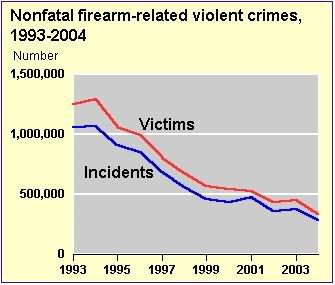I swear, you’d think I intimidate them or something. Reader Bob gave me a link to a web page that asked the question What Ever Happened to Gun Control? Like its disappearance as a political topic was a bad thing.
I questioned the author, an economist who writes on heath-care topics, on some of her “statistics,” and I invited her not once, not twice, but three times to discuss the topic of gun control either publicly or privately.
She declined. Oh well.
But the subject of this post comes from another comment posted at that site. One “robertdfeineman” wrote:
A couple of years ago I posted a diary about gun control where I suggested treating it as a public health issue. As I recall I defined several classes of gun control issues:
1. Accidental injury
1a. by children
1b. by adults
2. Injury in the course of a crime
3. Injury in the course of a domestic disturbance
4. Injury caused by a mentally unbalanced individual
5. Suicide
I asked those who opposed gun control to select any category of their choosing and suggest what steps should be taken to lessen the rate of injury.
As you have discovered vitriol was quickly forthcoming, however useful suggestions – none.
Even the example of Canada isn’t able to bring any sanity to the discussion. Canada has a fairly high level of gun ownership (mostly sports and hunting), but has a much lower level of misuse. There seems to be no discussion of why this is so.
Without getting too deep into the American psyche there just seems to be a vocal core of gun supporters who are motivated by something deeper than rational arguments. As with most such inexplicable attitudes it is likely that it has its basis in a deep seated fear, of what isn’t clear.
As simple observation will show other advanced countries, that don’t permit the same freedom of gun ownership and use, are not overrun by people in black helicopters, nor by crazed gangs or druggies, nor by criminals threatening home and family. Whence the insecurity?
Given that the US is in a fortress mentality mode (personal Hummers, gated communities, domestic surveillance, etc.) expecting rationality about guns seems unlikely for the immediate future.
Coming from a guy who apparently believes that the world is suffering from overpopulation and resource shortages (I guess he’s never heard of Paul Erlich and The Population Bomb), he seems to believe that capitalism is outmoded and needs to be replaced by a “steady-state” economy (AKA “zero-sum” – the model every socialist system has based its economic system on).
Quelle suprise.
But I thought I’d take a shot at providing some useful suggestions without vitriol.
Here we go:
1. Accidental injury
1a. by children
1b. by adults
The answer to this is obvious, ongoing, and highly successful.
Education, education, education.
And it’s obviously been working for quite some time, too. Accidental death and injury by firearm in this country is at an all-time low, and has been declining ever since we started collecting statistics. This despite the fact that 3-4 million new firearms are added to the total in private hands in this country each and every year. It doesn’t require new (and dubious) safety features on guns, it doesn’t require free trigger locks to be given away by government agencies, it simply requires education – and the firearms industry and the NRA are doing apparently a damned good job.
Which is more than can be said for the Brady Campaign or the Violence Policy Center.
Doubt me? Do you doubt the Centers for Disease Control?
Total accidental gunshot deaths by year:
1981 – 1,871 (Crude rate, 0.82/100,000)
1982 – 1,756
1983 – 1,695
1984 – 1,668
1985 – 1,649
…
1990 – 1,416
1991 – 1,441
1992 – 1,409
1993 – 1,521
1994 – 1,356
1995 – 1,225
…
2000 – 776
2001 – 802
2002 – 762
2003 – 730
2004 – 649
2005 – 789 (Crude rate 0.27/100,000)
The actual incidence of death by accidental gunshot wound has dropped 58%. The rate has dropped by 67% (the overall population has gone up over the same period.)
Over the period between 1981 and 2005 (25 years) the number of firearms in the U.S. has increased by approximately 100,000,000. Yes, that’s right, one hundred million, of which about 40 million were handguns. Over that same period the number of states with “shall-issue” concealed-carry laws has increased from eight (8) to 35 (now 37). The number of “no issue” states has declined from 15 to two.
I don’t know about you, but I call that “improvement.”
Topic: 2. Injury in the course of a crime
Well, for one thing, since 1990 the number of deaths and injuries from criminal assault have been declining rapidly to levels not seen since the 1960s. Homicide, highly variable over the nation’s history, has dropped dramatically, according to this Bureau of Justice Statistics chart:
Non-fatal attacks are down significantly, too:
What caused this? Well it wasn’t “gun control” by any indication. The only “gun control” law passed during this period was the 1994 “Assault Weapon Ban” (that wasn’t), but in 2005 even the New York Times admitted:
Gun crime has plummeted since the early 1990’s. But a study for the National Institute of Justice said that it could not “clearly credit the ban with any of the nation’s recent drop in gun violence.”
Research for the study in several cities did show a significant decline in the criminal use of assault weapons during the ban. According to the study, however, that decline was offset by the “steady or rising use” of other guns equipped with high-capacity magazines – ammunition-feeding devices that hold more than 10 rounds.
So, should one conclude from this that “high-capacity magazines” lead to a decrease in overall violent crime?
The first thing that leads to a decrease in injury in the course of crime is to reduce crime. How? Well, it would appear that a good economy helps. Of course, incarcerating more than 1% of the population might be contributing factor, too. I’ll leave that up to you to decide whether that’s a good thing or not. But how about defense with a firearm of your own?
Only about 29% of criminal assaults involve a perpetrator with a firearm, and even if they are so armed, defending yourself with your own firearm has proven to be the most likely way to escape without injury. That is, if you believe Gary Kleck’s analysis of Bureau of Justice Statistics National Crime Victimization survey data. Kleck’s study indicates that defending yourself with a firearm reduces your chances of injury below any other method, including not resisting at all.
Topic 3. Injury in the course of a domestic disturbance
That’s a tough one. Congress passed a law that is supposed to disarm anyone who has received so much as a ticket for misdemeanor domestic violence. Of course, like the Brady background check, the law has been equally effective at actually disarming dangerous people – that is “not at all.” Generally, in this situation on party or the other may get a restraining order, but these have proven to be nothing more than tissue paper. Reciprocal restraining orders only guarantee that the one who is willing to kill is ensured of a defenseless victim, and then a knife will do as well as a gun. Here I’m going to have to admit defeat, and state plainly that I see no way to legally, constitutionally, affect this problem.
Strike one!
Topic 4. Injury caused by a mentally unbalanced individual
Again, a law has been passed that supposedly disarms people who have been adjudged mentally imbalanced or a danger to themselves or others. Again, as the Virginia Tech massacre proved, the effectiveness of this law is less than stellar. Too, there is the doctor-patient relationship which is supposed to be legally sacrosanct, the fear being, of course, that if doctors can be compelled to report about their patients to the legal authorities, some (perhaps many) would refuse to seek help at all.
Personally, I’m convinced that the recent (last decade or two) upswing in rampage killing / suicides is due to the use of anti-depressants that have a bad effect on a tiny percentage of the people who use them. That percentage is so small as to be statistical noise, but it has resulted in the deaths of a significant number of people. What to do about it? I don’t know. It’s a Catch-22 situation, and again, the best I can hope for is that someone law-abiding and armed can end any such situation before the perpetrator decides he’s finished.
Topic 5. Suicide.
I have already considered this one in great detail. Basically, my conclusion is that while Americans do use firearms in large proportion to commit suicide, firearms are not the cause of their decision to end their own lives. America is on the low end of the scale for nations with relatively high GNPs, ranking below Norway, Germany, Sweden, Japan, Switzerland, France, Austria, Denmark and Finland for suicide rates. The leading method of suicide varies with each nation, but it appears that if you really want to kill yourself (as opposed to a “cry for help”) you find a way. This is especially true among young people, as evidenced by Australia’s youth suicide problem. For no apparent reason, in Australia the leading method of suicide of young men changed from firearms to asphyxiation by hanging. There were no gun laws passed during the period during which this occurred to account for the shift.
A study of the Brady 3-day waiting period found that it reduced the number of suicides by firearm among people 55 and older, but that it didn’t affect any overall suicide rate. In other words, people that might have used a firearm found another, equally effective method.
My conclusion here is that the appearance of firearms being a cause of suicide is an illusion. If all firearms disappeared tomorrow, the rate of suicide would be essentially unchanged.
So in answer to your questions:
1: We’ve tremendously reduced accidental death and injury through education, even with a massive increase in the number of firearms in curculation. Perhaps if we want to affect this particular problem even more, we should be teaching firearm safety education in schools alongside sex education.
2: We’ve greatly reduced death and injury due to criminal acts over the recent decade, without any notably effective new firearms legislation. The “Assault Weapons Ban” didn’t seem to have any effect, and the worst thing you can say about the massive increase the number of states that have passed “shall-issue” concealed carry laws is that those laws might not have been responsible for any of the reduction in crime.
3: Injury in domestic disturbances has also decreased, but nowhere near as much as with other types of violent crime, and here I admit defeat. In a nation founded on the concept of individual sovereignty and individual rights, I really don’t see where we can affect this particular problem except by allowing the threatened parties to be armed in their own defense, and the law just isn’t written that way.
4: Mentally unbalanced people deciding to commit suicide and taking strangers, coworkers, or loved ones along with them present the same problem. The only thing I can think of here is for those coworkers or loved ones to pay attention to the situation and try to get obviously disturbed people into mental health care. Unfortunately, given the same rights as everyone else, this does not seem to be effective.
5: The suicide problem appears to be one of false perception. Yes, a lot of Americans who choose to end their own lives choose to do it by means of a firearm, but that doesn’t mean that they wouldn’t find another way if access to a firearm was denied to them. If “gun access” caused suicide, America’s suicide rate would far exceed any other nation in the world.
But perhaps instead of considering the beam in America’s eye, our neighbors to the North should consider the one in their own. Even our Roger Ebert has recognized that, while Canadians don’t murder each other as often as Americans do, their violent crime rate far exceeds our own.
Maybe Canada needs more guns.
UPDATE: See More “Reasoned Discourse”





